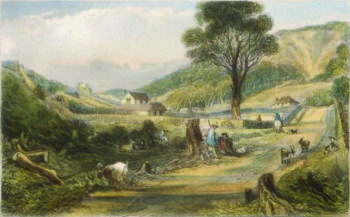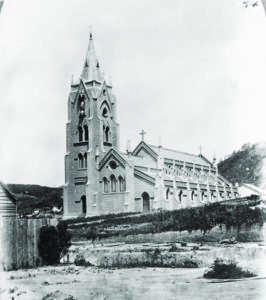Fr Jean Baptiste Petitjean SM ‘Parish Priest to all New Zealand’
Part 3 of 3
In the early morning of 1 May 1850, Bishop Philippe Viard celebrated Mass on the deck of the Clara as she sailed into Wellington harbour after a ten-day voyage from Auckland. This was his first Mass as bishop of the newly created Diocese of Wellington. Reflecting on the city of her birth, Katherine Mansfield wrote of "the singular charm and barrenness of that place". For the small group of Marists on the deck of the Clara as it sailed into Lambton harbour, the barrenness of colonial Wellington was readily apparent, and its charm was rather more elusive. Founded only ten years earlier, with a population of fewer than 5,000, Wellington in 1850 was little more than a straggling line of timber buildings clustered along the shore, with steep and largely deforested hills behind.
The Marists had expressed their feelings about the new assignment in a letter to their superiors in France before leaving Auckland. "Wellington is just a big desert, dry and barren… it would be hard to find even a few hundred Catholics". A survey in 1850 had identified only one Catholic Māori living in Wellington. The small congregation of European Catholics were served by Fr Jeremiah O’Reily OFM Cap from his small chapel on Hinau Hill, where St Mary of the Angels stands today. When he set foot on Pipitea Beach that May morning, Fr Jean Baptiste Petitjean was even more isolated from his beloved Māori Mission than he had been in Auckland.

View looking up Tinakori Rd, formerly Karori Rd, towards Hawkestone Street and Tinakori Hill 1847-1849
Bishop Viard took up residence on the Karori Road (modern Glenmore Street) and purchased land on Golders Hill in Thorndon, site of the current Cathedral of the Sacred Heart. Of the five Marist priests who arrived with Bishop Viard, only Fr Petitjean was to make Wellington his permanent home. But Fr Petitjean's travels were far from over. The new Diocese of Wellington also included the whole of the sparsely settled South Island. Bishop Viard's priests were responsible for a vast area, from Nelson in the north to Christchurch on the Canterbury Plains, Dunedin in the far south, and the isolated farms and settlements in between.
In the years following his arrival in Wellington Fr Petitjean travelled extensively throughout the length of the South Island. He was often entirely alone, walking long distances through wild country. The purpose of his journeys was to seek out Catholic families and individuals, many of Irish origin, scattered throughout the island. He would encourage them in their faith, administer the sacraments, and reassure them that their needs were not forgotten. "The missionary in his visits is like a shepherd seeking his flock in the desert", he wrote.
Fr Petitjean encountered a range of responses to his pastoral visits. He recounted that when he first celebrated Mass near Christchurch, one woman walked 12 miles through winter weather, carrying her baby, so that she could attend. In other cases, he found that long isolation from the life of the Church had led to a lapse in faith. On visiting a community where several children had been baptised by Bishop Pompallier fifteen years earlier, he wrote in despairing tones, "they have been left, one might say, like plants without water… it is too late". When he visited Riverton in the deep south, he was touched to learn that he was the first priest who had ever visited the Catholic community there.
Much of what we know about Fr Petitjean’s pastoral work comes from correspondence with his superiors, but there are other surviving letters which offer a more personal view of his life as a missionary, and of his lifelong attachment to his homeland. Before leaving France as a young man, Fr Petitjean had baptised his infant niece Adelaide Paillasson. He never saw her again, but once she reached adulthood, they struck up a remarkable correspondence. In 1857 when Adelaide was engaged to be married, she and her fiancé, Petrus Benoit, wrote to the distant uncle she had never known. Fr Petitjean replied on the night of Holy Thursday 1858, with great warmth and tenderness.
“My dear Adelaide… my first-born of all my spiritual posterity … My watch shows ten o'clock at night, and the moon is already high above the horizon, while you in France still enjoy full daylight … I imagine myself at Mornant [his home town]; I assist in spirit at the beautiful procession at night; I walk again through those streets I know so well, I see again the torches … Dear Petrus, dear Adelaide, come, let us embrace one another”.

St Mary's Cathedral, Hill Street, Thorndon, Wellington, c. 1880s
This correspondence was to continue for many years. When Adelaide and her husband offered to pay for Fr Petitjean to return to France, his reply tells us a great deal about how he saw his work among the faithful in New Zealand.
“To decide the question whether I should return to France, I appeal to your mother’s heart. Could you make up your mind to abandon you new-born children…? Your reply is certain. Well then, my dear, you have decided for me. Au revoir then, In heaven".
As he grew older and less able to travel, Fr Petitjean spent more of his time in Wellington, visiting the hospitals and prisons, eloquently rebutting attacks on Catholicism in the newspapers, and ministering to the people of what was, by then, New Zealand's capital.
By the time he died by the altar of St Mary’s Cathedral on the evening of 21 September 1876, his decades of missionary service had made him 'parish priest to all New Zealand'.
Selected reading list:
Steadfast in Hope: The Story of the Catholic Diocese of Wellington 1850-2000, Michael O'Meeghan SM
On Golders Hill: A History of Thorndon Parish, Dan Kelly
A Brief History of the Catholic Church in New Zealand, E.R. Simmons
Sons of France, Mary Catherine Goulter

 Entries(RSS)
Entries(RSS)